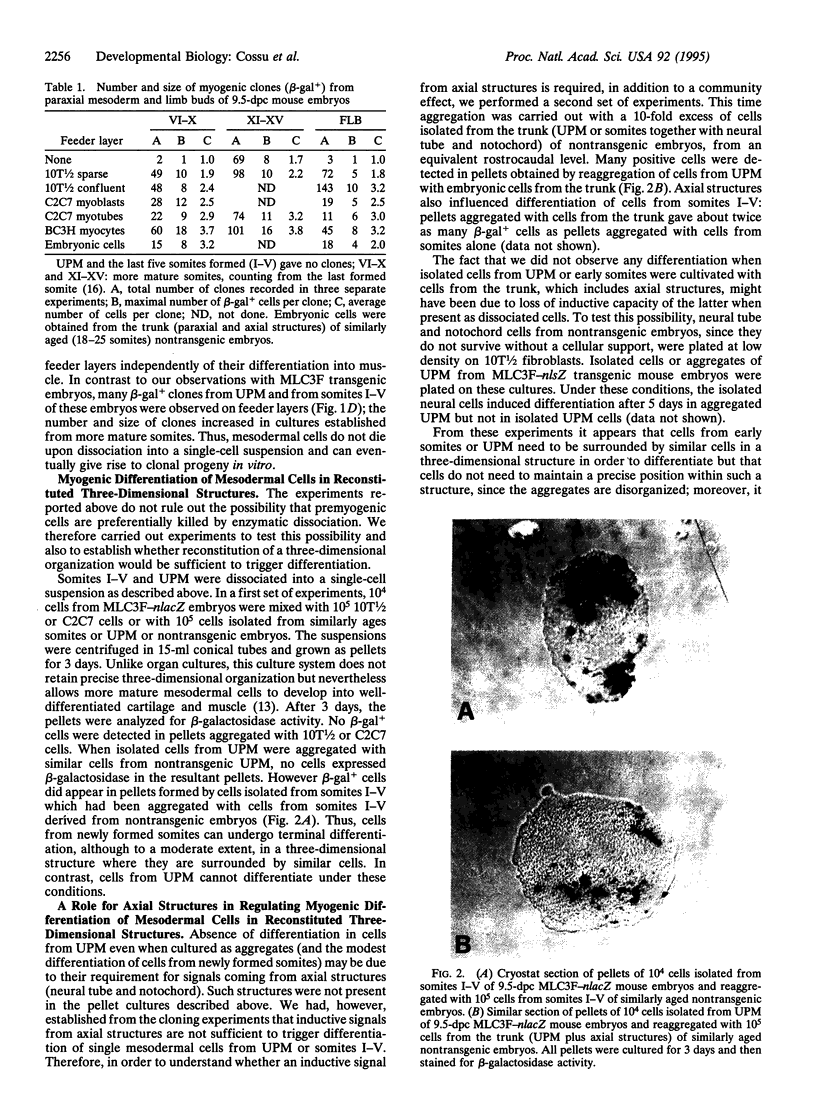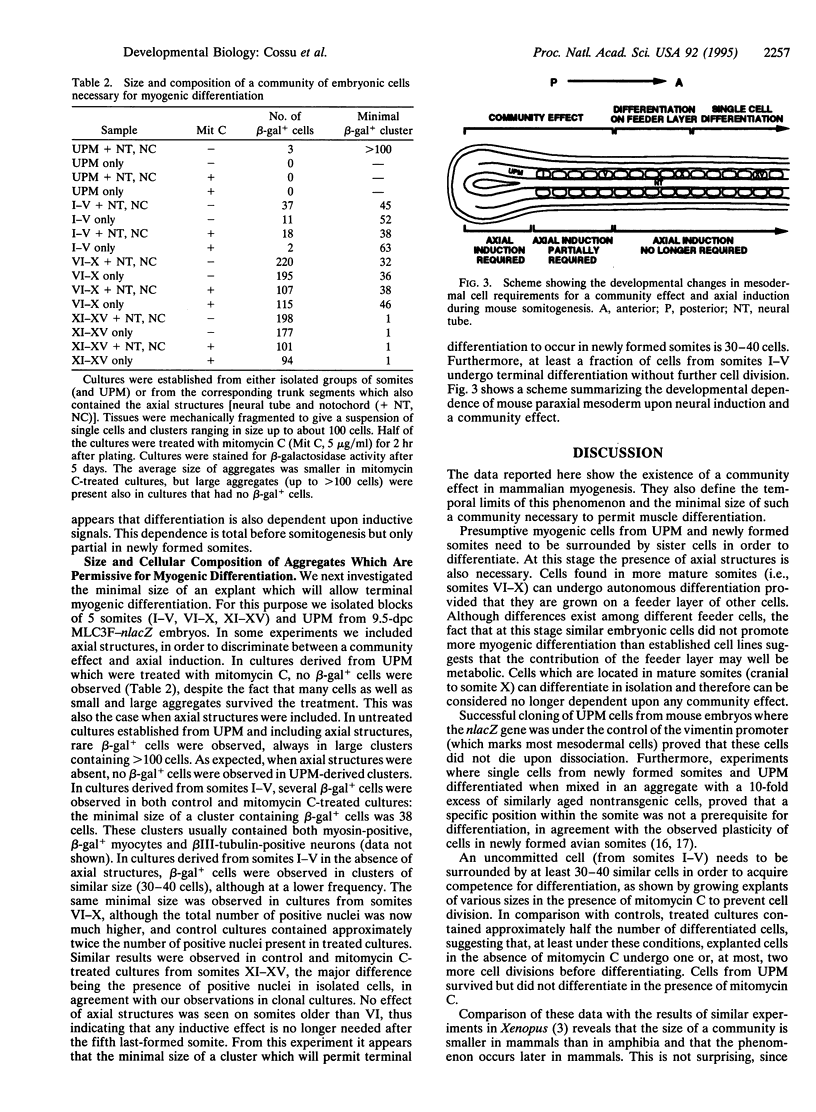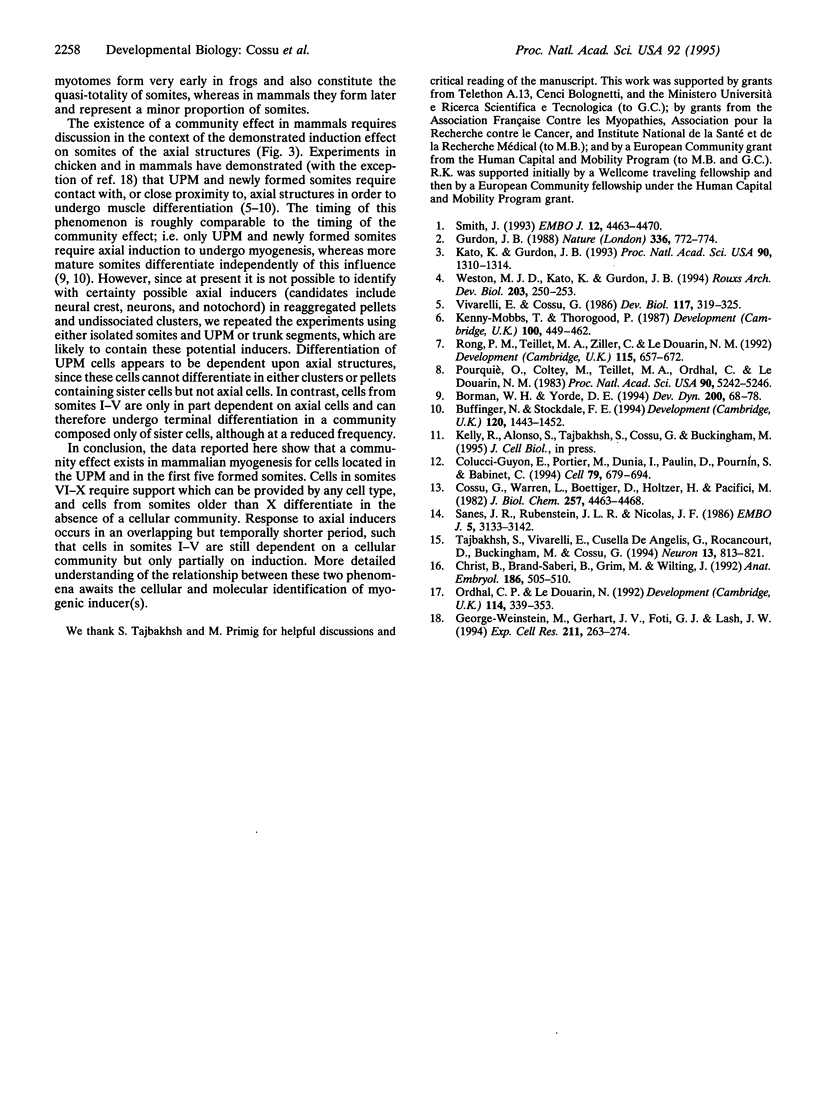Abstract
The differentiation potential of early mammalian myogenic cells was tested under clonal culture conditions. Cells were isolated from paraxial mesoderm and limb buds of transgenic mouse embryos at 9.5 days after conception and grown in culture at clonal density either on collagen-coated dishes or on various feeder cell layers. The transgene used contained a reporter gene encoding beta-galactosidase with a nuclear localization signal under the control of regulatory sequences from the gene for fast myosin light chain 3, so that beta-galactosidase staining indicated the presence of differentiated muscle cells. After 5 days in culture, the number and size of beta-galactosidase-positive (beta-gal+) clones were recorded. Cells isolated from somites I-V (the last five somites to have formed) or from unsegmented paraxial mesoderm did not give rise to any beta-gal+ clones. Cells isolated from somites VI-X or from the forelimb bud gave rise to beta-gal+ clones, but only on feeder cells. Cells from somites XI or older gave rise to beta-gal+ clones independently of the substrate. However, when cells isolated from unsegmented paraxial mesoderm or somites I-V were cultured with nontransgenic cells from the trunk (including neural tube and notochord), differentiation occurred on condition that the cells were in a three-dimensional aggregate, even though their specific position in the somite had been lost. By culturing explants ranging in size from 1 to < 100 cells in the presence of an inhibitor of cell division, we determined that a minimal number of 30-40 cells is required for mesodermal cells to differentiate.
Full text
PDF




Images in this article
Selected References
These references are in PubMed. This may not be the complete list of references from this article.
- Borman W. H., Yorde D. E. Barrier inhibition of a temporal neuraxial influence on early chick somitic myogenesis. Dev Dyn. 1994 May;200(1):68–78. doi: 10.1002/aja.1002000107. [DOI] [PubMed] [Google Scholar]
- Buffinger N., Stockdale F. E. Myogenic specification in somites: induction by axial structures. Development. 1994 Jun;120(6):1443–1452. doi: 10.1242/dev.120.6.1443. [DOI] [PubMed] [Google Scholar]
- Christ B., Brand-Saberi B., Grim M., Wilting J. Local signalling in dermomyotomal cell type specification. Anat Embryol (Berl) 1992 Oct;186(5):505–510. doi: 10.1007/BF00185464. [DOI] [PubMed] [Google Scholar]
- Colucci-Guyon E., Portier M. M., Dunia I., Paulin D., Pournin S., Babinet C. Mice lacking vimentin develop and reproduce without an obvious phenotype. Cell. 1994 Nov 18;79(4):679–694. doi: 10.1016/0092-8674(94)90553-3. [DOI] [PubMed] [Google Scholar]
- Cossu G., Warren L., Boettiger D., Holtzer H., Pacifici M. Similar glycopeptides in normal chondroblasts and in Rous sarcoma virus-transformed fibroblasts. J Biol Chem. 1982 Apr 25;257(8):4463–4468. [PubMed] [Google Scholar]
- George-Weinstein M., Gerhart J. V., Foti G. J., Lash J. W. Maturation of myogenic and chondrogenic cells in the presomitic mesoderm of the chick embryo. Exp Cell Res. 1994 Apr;211(2):263–274. doi: 10.1006/excr.1994.1086. [DOI] [PubMed] [Google Scholar]
- Gurdon J. B. A community effect in animal development. Nature. 1988 Dec 22;336(6201):772–774. doi: 10.1038/336772a0. [DOI] [PubMed] [Google Scholar]
- Kato K., Gurdon J. B. Single-cell transplantation determines the time when Xenopus muscle precursor cells acquire a capacity for autonomous differentiation. Proc Natl Acad Sci U S A. 1993 Feb 15;90(4):1310–1314. doi: 10.1073/pnas.90.4.1310. [DOI] [PMC free article] [PubMed] [Google Scholar]
- Kenny-Mobbs T., Thorogood P. Autonomy of differentiation in avian branchial somites and the influence of adjacent tissues. Development. 1987 Jul;100(3):449–462. doi: 10.1242/dev.100.3.449. [DOI] [PubMed] [Google Scholar]
- Ordahl C. P., Le Douarin N. M. Two myogenic lineages within the developing somite. Development. 1992 Feb;114(2):339–353. doi: 10.1242/dev.114.2.339. [DOI] [PubMed] [Google Scholar]
- Pourquié O., Coltey M., Teillet M. A., Ordahl C., Le Douarin N. M. Control of dorsoventral patterning of somitic derivatives by notochord and floor plate. Proc Natl Acad Sci U S A. 1993 Jun 1;90(11):5242–5246. doi: 10.1073/pnas.90.11.5242. [DOI] [PMC free article] [PubMed] [Google Scholar]
- Rong P. M., Teillet M. A., Ziller C., Le Douarin N. M. The neural tube/notochord complex is necessary for vertebral but not limb and body wall striated muscle differentiation. Development. 1992 Jul;115(3):657–672. doi: 10.1242/dev.115.3.657. [DOI] [PubMed] [Google Scholar]
- Sanes J. R., Rubenstein J. L., Nicolas J. F. Use of a recombinant retrovirus to study post-implantation cell lineage in mouse embryos. EMBO J. 1986 Dec 1;5(12):3133–3142. doi: 10.1002/j.1460-2075.1986.tb04620.x. [DOI] [PMC free article] [PubMed] [Google Scholar]
- Smith J. C. Mesoderm-inducing factors in early vertebrate development. EMBO J. 1993 Dec;12(12):4463–4470. doi: 10.1002/j.1460-2075.1993.tb06135.x. [DOI] [PMC free article] [PubMed] [Google Scholar]
- Tajbakhsh S., Vivarelli E., Cusella-De Angelis G., Rocancourt D., Buckingham M., Cossu G. A population of myogenic cells derived from the mouse neural tube. Neuron. 1994 Oct;13(4):813–821. doi: 10.1016/0896-6273(94)90248-8. [DOI] [PubMed] [Google Scholar]
- Vivarelli E., Cossu G. Neural control of early myogenic differentiation in cultures of mouse somites. Dev Biol. 1986 Sep;117(1):319–325. doi: 10.1016/0012-1606(86)90374-x. [DOI] [PubMed] [Google Scholar]




